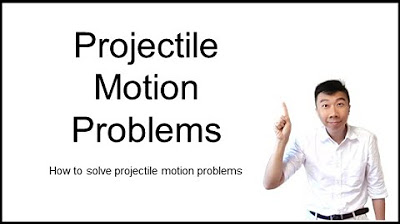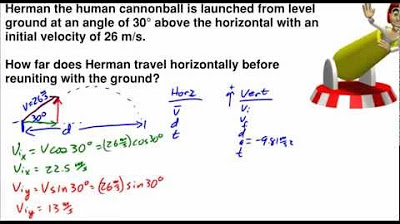Horizontally launched projectile | Two-dimensional motion | Physics | Khan Academy
TLDRThe video script discusses the physics of horizontally launched projectile motion, emphasizing the common mistake of incorrectly assuming an initial vertical velocity. It uses the example of a person running off a cliff to illustrate how to calculate the horizontal distance traveled before hitting the water, highlighting the importance of recognizing that the initial vertical velocity is zero and that horizontal and vertical motions are independent. The solution involves finding the time of flight using the vertical displacement and then using this time to determine the horizontal distance, given the constant horizontal velocity.
Takeaways
- 🚀 A horizontally launched projectile starts with a completely horizontal velocity and no vertical component.
- 🌐 The horizontal and vertical motions in a projectile occur independently of each other.
- 🎾 For a horizontally launched projectile, the initial vertical velocity is zero, not the given horizontal velocity.
- 📉 The horizontal velocity remains constant throughout the motion, assuming no external forces like air resistance.
- 🔽 The vertical displacement for a freely falling object is considered negative in the downward direction.
- 🔄 The time of flight for the projectile is the same for both horizontal and vertical displacements.
- 🕒 To find the horizontal distance, first calculate the time of flight using the vertical displacement and then apply it to the horizontal motion.
- 📌 The key to solving horizontally launched projectile problems is understanding the separation of horizontal and vertical motions and their respective initial conditions.
- 🧠 Remember that the initial vertical velocity is not given in the problem statement; it must be deduced from the nature of the projectile motion.
- 🛑 Avoid the common mistake of equating the horizontal velocity with the vertical velocity at the start of the motion.
- 🏆 For practical applications, like cliff diving, calculating the horizontal distance can help determine the safe path to avoid obstacles.
Q & A
What is a horizontally launched projectile?
-A horizontally launched projectile refers to any object that is launched with an initial velocity that is completely horizontal, meaning it has no vertical component at the start.
Why do people often get confused with horizontally launched projectile problems?
-People often get confused because they mistakenly assume that the initial vertical velocity is the same as the horizontal velocity, which is not the case; the initial vertical velocity is actually zero.
How does the horizontal velocity affect the projectile's motion?
-The horizontal velocity remains constant throughout the projectile's motion because there are no forces acting in the horizontal direction (assuming no air resistance and no propulsion).
What is the role of gravity in the vertical motion of a projectile?
-Gravity causes the projectile to accelerate downwards at a rate of approximately 9.8 meters per second squared, which continually increases the vertical velocity of the projectile.
How can you calculate the horizontal distance a projectile travels before hitting the ground?
-First, you calculate the time of flight using the vertical displacement and acceleration due to gravity. Then, you use this time to find the horizontal distance by multiplying the constant horizontal velocity by the time.
What are the key components to consider when solving a horizontally launched projectile problem?
-The key components are the initial horizontal velocity, the acceleration due to gravity, the vertical displacement (which is negative), and the time of flight.
Why is it important to treat downward displacement as negative in these problems?
-It is important because it is a convention to treat downward and leftward directions as negative in physics problems, which helps in maintaining consistency in equations and calculations.
How does air resistance affect the motion of a projectile in real-world scenarios?
-In real-world scenarios, air resistance can decrease the horizontal velocity and increase the vertical deceleration, thus affecting the distance and trajectory of the projectile. However, in idealized problems without air resistance, these effects are neglected.
What is the significance of the initial vertical velocity being zero in the context of the problem?
-The initial vertical velocity being zero is significant because it clarifies that there is no upward or downward motion at the start, which is crucial for accurately calculating the projectile's horizontal distance without introducing incorrect values into the equations.
How long does it take for a person to fall 30 meters vertically in the given example?
-In the given example, it takes approximately 2.47 seconds for a person to fall 30 meters vertically.
What is the horizontal distance the person travels in the 2.47 seconds of free fall?
-The person travels approximately 12.4 meters horizontally in the 2.47 seconds of free fall, assuming a constant horizontal velocity of 5 meters per second.
Outlines
🚀 Introduction to Horizontally Launched Projectile Motion
The instructor begins by discussing the concept of horizontally launched projectile motion, emphasizing a common misconception that people often encounter. A horizontally launched projectile refers to an object launched with an initial velocity that is entirely horizontal, such as a ball rolling off a table. The example of a person cliff diving or base jumping with an initial horizontal velocity is used to illustrate the concept. The key point is that while the object moves horizontally, it also falls vertically due to gravity, but the horizontal velocity remains constant throughout the motion.
🧠 Understanding the Physics Behind the Motion
The paragraph delves into the physics of a horizontally launched projectile, clarifying that the horizontal and vertical motions are independent of each other. The instructor explains that the horizontal velocity remains constant, while the vertical velocity changes due to gravity. The example continues with the person running off a cliff with an initial velocity of five meters per second, and the cliff being 30 meters tall. The challenge is to determine how far the person travels horizontally before hitting the water. The instructor emphasizes the importance of recognizing that the initial vertical velocity is zero, which is a point where many people make mistakes.
📐 Solving the Problem: Time and Displacement
The final paragraph focuses on solving the problem by first determining the time it takes for the person to fall 30 meters vertically. The instructor uses the formula for vertical displacement under constant acceleration (ignoring air resistance) to calculate that the time taken is 2.47 seconds. This time represents the duration of the fall, which is also the time it takes for the horizontal displacement to occur. The instructor then applies the same principle to find the horizontal displacement (dx), using the constant horizontal velocity and the time calculated. The result is an approximate horizontal displacement of 12.4 meters, which is crucial information for a cliff diver to know in order to avoid obstacles like rocks at the bottom.
Mindmap
Keywords
💡Horizontally Launched Projectile
💡Initial Velocity
💡Projectile Motion
💡Independent Horizontal and Vertical Motion
💡Displacement
💡Acceleration
💡Time of Flight
💡Free Fall
💡Cliff Diver
💡Mistakes in Projectile Motion
Highlights
The concept of a horizontally launched projectile is introduced, which is any object launched with a completely horizontal velocity.
An example of a horizontally launched projectile is a ball rolling off a flat table.
The importance of understanding the independent nature of horizontal and vertical motions in projectile problems is emphasized.
The horizontal velocity remains constant throughout the projectile's motion, unaffected by gravity.
The vertical velocity starts at zero and increases due to gravity, which is represented as a negative acceleration.
The initial velocity for a horizontally launched projectile is given as an example, with a person running off a cliff at 5 meters per second.
The common mistake of assuming an initial vertical velocity equal to the horizontal velocity is pointed out.
The correct approach is to use the negative displacement and remember that the initial vertical velocity is zero.
The method for solving for time using the vertical displacement and acceleration due to gravity is explained.
The time of fall is calculated to be 2.47 seconds, which is longer than one might expect.
The horizontal displacement is found by using the time calculated from the vertical motion and the constant horizontal velocity.
The calculated horizontal displacement is approximately 12.4 meters, which has practical implications for cliff divers.
The key takeaway is to recognize that the initial vertical velocity is zero and to correctly apply negative displacements in calculations.
The problem-solving approach for horizontally launched projectile problems is outlined, emphasizing the separation of horizontal and vertical motions.
The practical application of this physics problem is demonstrated through the scenario of a cliff diver.
The transcript serves as a guide to avoid common mistakes and to correctly apply the principles of physics to real-world scenarios.
Transcripts
Browse More Related Video
5.0 / 5 (0 votes)
Thanks for rating:





